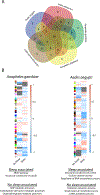Do Mosquitoes Sleep?
- PMID: 32952061
- PMCID: PMC8094063
- DOI: 10.1016/j.pt.2020.08.004
Do Mosquitoes Sleep?
Abstract
Sleep is a phenomenon conserved across the animal kingdom, where studies on Drosophila melanogaster have revealed that sleep phenotypes and molecular underpinnings are similar to those in mammals. However, little is known about sleep in blood-feeding arthropods, which have a critical role in public health as disease vectors. Specifically, sleep studies in mosquitoes are lacking despite considerable focus on how circadian processes, which have a central role in regulating sleep/wake cycles, impact activity, feeding, and immunity. Here, we review observations which suggest that sleep-like states likely occur in mosquitoes and discuss the potential role of sleep in relation to mosquito biology and their ability to function as disease vectors.
Keywords: circadian rhythms; mosquito biology; mosquitoes; sleep; vectorial capacity.
Copyright © 2020 Elsevier Ltd. All rights reserved.
Figures



References
-
- Rajagopalan A and Ilboudo CM (2017) Mosquito-borne infections. Pediatrics in Review 38, 340–342 - PubMed
-
- Guruprasad NM et al. (2014) Wolbachia-a foe for mosquitoes. Asian Pacific Journal of Tropical Disease 4, 78–81
Publication types
MeSH terms
Grants and funding
LinkOut - more resources
Full Text Sources
Medical

